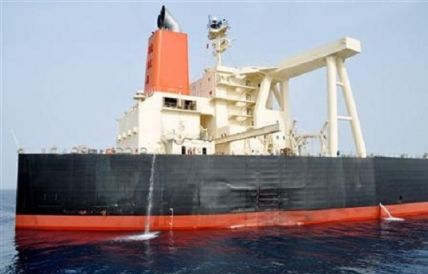|
|
Energy
'M' Stands for Mystery
Tuesday, August 10, 2010
 M. Star
M. Star
By Alex Calvo
The sea has always been a breeding ground for all sorts of tales and mysteries, from phantom ships to strange aquatic creatures. The advent of new technologies, while making navigation much safer, does not seem to have put an end to our fascination with all sorts of unexplained phenomena originating far from shore.
In the last couple of weeks, the media and expert commentators have speculated on the likely causes of the damage sustained by M. Star, a Very Large Crude Carrier (VLCC), on July 28, while carrying about 2.3 million barrels of oil from Das Island Port in the United Arab Emirates to Japan.
The Owner's Version
The first version of the incident, released by the ship's owner, Japan's Mitsui OSK shipping lines, was that the M. Star had suffered an explosion resulting from an attack at 12:30 am local time (20:30 GMT), while less than ten miles from the coast of the United Arab Emirates and Oman. It resulted in damage to the ship's starboard side and injuries to a crew member, but the M. Star could sail under its own power to Fujairah (UAE).
The company stated that a member of the crew saw a light on the horizon just before the explosion, claiming that this was evidence of an attack. In addition, a spokeswoman explained that there was nothing capable of exploding where the ship was damaged.
The First Denials
As soon as this explanation became known, conflicting accounts began to surface, centered not only on the details, but also on the ultimate cause of the incident.
Some local sources denied an explosion had taken place, and blamed the damage on a 3.4 magnitude earthquake whose epicenter was near Bandar Abbas in Iran.
The US Navy, whose 5th Fleet is stationed in the region, claimed the cause of the incident was not known to them, and revealed that the M. Star had not sought assistance from any of their units.
Stratfor, a Texas-based private intelligence company, dismissed Mitsui OSK's linkage between an alleged flash of light and a terrorist attack, explaining that in the Strait of Hormuz there are many gas flares from the oil and gas rigs dotting the coast.
This source also claimed that since VLCCs are very complex ships, some sort of malfunction could not be ruled out.
Concerning the earthquake hypothesis, Stratfor stated that its weakness and distance (50 miles) from the ship made it a doubtful proposition. In addition, no other ships were affected.
A Collision?
Once pictures of the ship became available, further doubts were cast on the possibility it had suffered a terrorist attack. Stratfor claimed the damage was of the kind usually suffered after a collision, with a ship or another object, a possibility reinforced by "the concave shape of the indentation" and the lack of "evidence of pock marks, gas washing, burning, or rupturing of the hull."
A Militant Group Claims Responsibility
On August 4 there was a new twist when the Brigades of Abdullah Azzam claimed, in a posting in the Al-Faloja jihadist forum, that they had deployed a suicide bomber against the M. Star. The credibility of the forum led some observers to treat the claim cautiously, avoiding dismissing it out of hand.
The Brigades said they had conducted the attack as "economic jihad" and as a tribute to Sheikh Omar Abdel Rahman, a terrorist serving a life sentence in the United States.
The possibility of a failed suicide attack was reinforced by a report by the Emirates News Agency quoting an UAE Coast Guard source who claimed that local experts "found a dent on the starboard side above the waterline and remains of homemade explosives on the hull," adding that, "Probably the tanker had encountered a terrorist attack from a boat loaded with explosives."
However, many observers remain unconvinced. Orbat, an Indian security and defense website, wrote that the damage suffered by the tanker is "a perfect rectangle," which begs the question, "Would an explosives-laden boat have caused damage in that shape?."
Conclusions
It is still unclear exactly what happened to the M. Star. If the findings of traces of explosives are confirmed, the original report of an explosion, probably of terrorist origin, would gain currency. Otherwise some sort of collision may end up being seen as the most likely explanation.
Whatever happened, two things are clear: that the waters in which the accident took place are crucial to the global economy and vital to Japan's national security; and, second, that the safety of Sea Lanes of Communication (SLOC) in Asia are by no means assured, being threatened by both state and non-state actors.
Faced with this double reality, it can be expected that the upgrade of Japanese naval capabilities evident in recent years will continue.
A more controversial issue may be a deeper coordination of such efforts with countries like India or Australia, which share an interest in defending freedom of navigation in these waters.
Such concern is shared even by former foes such as Vietnam and the United States, as seen on Sunday, when the aircraft carrier USS George Washington visited Vietnamese waters near Da Nang. The visit was a logical corollary to the words of Secretary of State Clinton, uttered in Hanoi in July during the ASEAN Regional Forum, stating that freedom of the seas and a peaceful settlement of territorial controversies in the South China Sea were in the national interest of the United States.
Alex Calvo is Professor of International Relations and International Law, European University in Barcelona (Spain).
PanOrient News
© PanOrient News All Rights Reserved.
|
|